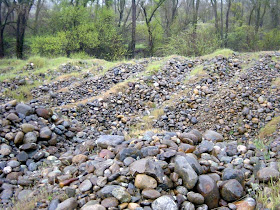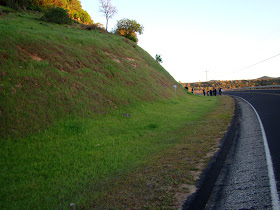 |
| The San Andreas fault in Lone Pine Canyon near Cajon Pass in Southern California. Photo by Mrs. Geotripper |
If there is anything that people know about California, it's the San Andreas fault. In a vague sense anyway...California has a lot of earthquakes that many people assume happen along the San Andreas (most don't), that there are occasional BIG ONES that happen on the fault (some of them, but not all), and if popular culture as expressed in movies like the original 1978 version of Superman reflects common knowledge, no one knows where it is or what it looks like (oh, and California is going to fall into the sea).
Still, the San Andreas is a fundamental part of the structure of California, and it is indeed capable of causing a great deal of seismic havoc, with some parts of the state considered at a high risk of moderate to large earthquakes. If one is curious about seeing the state's most famous fault line, there are a great many places to explore it, some in surprisingly visible locations. We are exploring one of them today in a segment of my "Other California" blog series.
Thousands upon thousands of cars follow Interstate 15 daily across Cajon Pass on their way to Las Vegas or their jobs in the L.A. Basin. I imagine few of the drivers know they are crossing California's most famous fault just a few miles north of the Interstate 15/Interstate 215 above San Bernardino. For a few moments, travelers are treated with a spectacular view up the linear track of Lone Pine Valley (the picture at the top of today's post shows the view, taken at 65 mph). I explored the lower end of Lone Pine Canyon and the "mysterious" Lost Lake (really not mysterious) in a post several years ago (click here to see it), but a weekend or two ago I had a chance to explore the upper end for the first time in a few decades.
 |
| The Mormon Rocks (or Rock Candy Mountains) expose the 18-20 million year old Cajon Formation. Interstate 15 climbs towards Cajon Pass on the skyline. |
The San Andreas fault is not a single break, but is instead a half-mile wide system of different slices of crust. Constant shearing over the last few million years by fault motions has left the rock fractured and easily eroded, forming the distinct linear valley of Lone Pine Canyon.
The series of fault blocks have formed a series of benches and scarps on the southwest side of the canyon, and a few offset channels are easily seen in the chaparral-covered hillsides (above).
Approaching the upper end of Lone Pine Canyon, we can see an odd hill in the middle of the valley. Looking at the steep slope to the right, it is apparent that we are looking at a rather large debris avalanche, caused no doubt by an earthquake along this stretch of the fault (above). The road skirts the lower end of the slide, confirming the nature of the hill with the broken and brecciated rock (below). There are plenty of candidates for the causative event; major earthquakes happened along this stretch of the fault in 1857(info here), 1812 (info here), and as many as a dozen other times in the last 1,500 years. There is a distinct warning in the earthquake history for this stretch of the San Andreas: the recurrence interval of large quakes is just over a century but it has been more than 150 years since the last major event.
The road reaches the top of the canyon, and a short walk along the ridge at the summit provides a spectacular view back down Lone Pine Canyon towards Interstate 15, and the two largest mountains in Southern California, San Gorgonio Peak and San Jacinto Peak. The fault passes between them on the way to Palm Springs and the Salton Sea.
There is a large outcrop at the head of the canyon that exposes highly sheared rocks from the fault zone. The original rocks may have included the Pelona schist and granitic rocks but they are almost unrecognizable in hand samples.
But one thing is kind of cool: how often can you hold a major fault zone in your hand?
The road through Lone Pine Canyon ends in the village of Wrightwood, the subject of our previous post about a recurring mudflow originating in the Pelona Schist on the high ridges above. As if they didn't have enough to worry about...
The Other California is my continuing blog series on the geologically fascinating places in our fair state that don't always make it onto the tourist postcards.












































+b.jpg)


